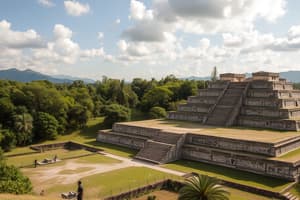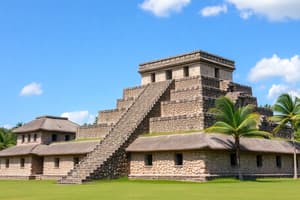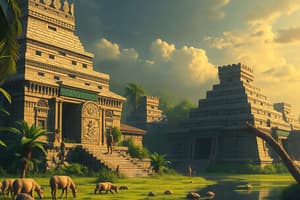Podcast
Questions and Answers
Which staple crops were primarily cultivated in Mesoamerica?
Which staple crops were primarily cultivated in Mesoamerica?
- Wheat, potatoes, and yams
- Rice, barley, and quinoa
- Maize, beans, and squash (correct)
- Sorghum, millet, and cassava
What architectural style is associated with Pueblo societies in the American Southwest?
What architectural style is associated with Pueblo societies in the American Southwest?
- Stone castles
- Multi-story adobe dwellings (correct)
- Grass huts
- Wooden log cabins
What was the main purpose of the Iroquois Confederacy's formation?
What was the main purpose of the Iroquois Confederacy's formation?
- To establish trade with Europeans
- To develop a common language
- To promote agricultural practices
- To unite tribes against invasion (correct)
Which of the following was required for the Iroquois Grand Council to make decisions?
Which of the following was required for the Iroquois Grand Council to make decisions?
Which tribe joined the Iroquois Confederacy in 1722?
Which tribe joined the Iroquois Confederacy in 1722?
Which type of ceremonial practices were common among Pueblo societies?
Which type of ceremonial practices were common among Pueblo societies?
The Great Law of Peace established what type of society in the Iroquois Confederacy?
The Great Law of Peace established what type of society in the Iroquois Confederacy?
What trade goods were likely exchanged between Pueblo societies and Mesoamerica?
What trade goods were likely exchanged between Pueblo societies and Mesoamerica?
What was the primary purpose of the Middle Passage?
What was the primary purpose of the Middle Passage?
Which of the following items were commonly produced by enslaved people in the Americas?
Which of the following items were commonly produced by enslaved people in the Americas?
What kind of resistance was NOT commonly seen among enslaved Africans during the Middle Passage?
What kind of resistance was NOT commonly seen among enslaved Africans during the Middle Passage?
Which of the following describes a consequence of the Columbian Exchange?
Which of the following describes a consequence of the Columbian Exchange?
Which of the following was NOT a type of good exchanged during the Columbian Exchange?
Which of the following was NOT a type of good exchanged during the Columbian Exchange?
What animal was introduced to the New World through the Columbian Exchange?
What animal was introduced to the New World through the Columbian Exchange?
Which was a significant environmental change caused by the Columbian Exchange?
Which was a significant environmental change caused by the Columbian Exchange?
What disease was NOT introduced to the Americas as part of the Columbian Exchange?
What disease was NOT introduced to the Americas as part of the Columbian Exchange?
What was the primary function of caravels in early exploration?
What was the primary function of caravels in early exploration?
How did astrolabes improve navigation for early explorers?
How did astrolabes improve navigation for early explorers?
What were the three primary motivations of Spanish Conquistadors as summarized by 'God, Gold, and Glory'?
What were the three primary motivations of Spanish Conquistadors as summarized by 'God, Gold, and Glory'?
Which ship design feature of caravels made them unique for exploration?
Which ship design feature of caravels made them unique for exploration?
Which of the following best describes the economic incentive for the Conquistadors?
Which of the following best describes the economic incentive for the Conquistadors?
Which historical figure is famously known for his successful circumnavigation of the globe?
Which historical figure is famously known for his successful circumnavigation of the globe?
What was one of the key benefits of using caravels for maritime exploration?
What was one of the key benefits of using caravels for maritime exploration?
What role did religious zeal play in the actions of Conquistadors?
What role did religious zeal play in the actions of Conquistadors?
What was the primary goal of the Spanish in their colonies?
What was the primary goal of the Spanish in their colonies?
How did the French approach their colonization compared to the Spanish?
How did the French approach their colonization compared to the Spanish?
What differentiates the economic focus of Northern and Southern English colonies?
What differentiates the economic focus of Northern and Southern English colonies?
What was a common outcome of Spanish colonization techniques regarding Indigenous populations?
What was a common outcome of Spanish colonization techniques regarding Indigenous populations?
What were the varying motivations for colonization among the Spanish, French, and English?
What were the varying motivations for colonization among the Spanish, French, and English?
What was the primary purpose of the Laws of the Indies?
What was the primary purpose of the Laws of the Indies?
What significant reform did the 'New Laws' introduced in 1542 aim to achieve regarding the encomienda system?
What significant reform did the 'New Laws' introduced in 1542 aim to achieve regarding the encomienda system?
Which of the following describes the effectiveness of the 'New Laws'?
Which of the following describes the effectiveness of the 'New Laws'?
What was Bartolome de las Casas' main argument during the Valladolid debate?
What was Bartolome de las Casas' main argument during the Valladolid debate?
Which position did Juan Ginés de Sepúlveda take during the Valladolid debate?
Which position did Juan Ginés de Sepúlveda take during the Valladolid debate?
What was one primary political motivation behind European exploration?
What was one primary political motivation behind European exploration?
What central issue was debated during the Valladolid debate in 1550?
What central issue was debated during the Valladolid debate in 1550?
What was a significant impact of Bartolome de las Casas' arguments during the Valladolid debate?
What was a significant impact of Bartolome de las Casas' arguments during the Valladolid debate?
Which factor significantly weakened Indigenous resistance to European colonization?
Which factor significantly weakened Indigenous resistance to European colonization?
Which of the following describes the perception of indigenous people by Sepúlveda during the Valladolid debate?
Which of the following describes the perception of indigenous people by Sepúlveda during the Valladolid debate?
How did European weaponry contribute to their success in colonizing the Americas?
How did European weaponry contribute to their success in colonizing the Americas?
What psychological tactic did Europeans use to intimidate Indigenous populations?
What psychological tactic did Europeans use to intimidate Indigenous populations?
What impact did disease have on the Indigenous populations during European colonization?
What impact did disease have on the Indigenous populations during European colonization?
How were European colonial possessions organized in the Americas?
How were European colonial possessions organized in the Americas?
Which of the following was considered a method of consolidating control over territories by Europeans?
Which of the following was considered a method of consolidating control over territories by Europeans?
What common purpose did personal ambition and curiosity serve among explorers?
What common purpose did personal ambition and curiosity serve among explorers?
Flashcards
Mesoamerica
Mesoamerica
A region in Central America, encompassing Mexico, Guatemala, Belize, El Salvador, Honduras, Nicaragua, and Costa Rica.
Major Mesoamerican Civilizations
Major Mesoamerican Civilizations
Major civilizations in Mesoamerica include Olmec, Maya, Zapotec, Teotihuacan, Aztec, and Inca.
Pueblos
Pueblos
A group of Native American tribes in the American Southwest, known for their multi-story adobe dwellings and unique pottery styles.
Mesoamerican Staple Crops (Maize, Beans, Squash)
Mesoamerican Staple Crops (Maize, Beans, Squash)
Signup and view all the flashcards
Iroquois Confederacy
Iroquois Confederacy
Signup and view all the flashcards
Great Law of Peace
Great Law of Peace
Signup and view all the flashcards
Iroquois Role in Colonial Wars
Iroquois Role in Colonial Wars
Signup and view all the flashcards
Iroquois Territory
Iroquois Territory
Signup and view all the flashcards
What is Circumnavigation?
What is Circumnavigation?
Signup and view all the flashcards
What are Caravels?
What are Caravels?
Signup and view all the flashcards
What is an Astrolabe?
What is an Astrolabe?
Signup and view all the flashcards
What is 'God, Gold, and Glory'?
What is 'God, Gold, and Glory'?
Signup and view all the flashcards
What is 'God' in 'God, Gold, and Glory'?
What is 'God' in 'God, Gold, and Glory'?
Signup and view all the flashcards
What is 'Gold' in 'God, Gold, and Glory'?
What is 'Gold' in 'God, Gold, and Glory'?
Signup and view all the flashcards
What is 'Glory' in 'God, Gold, and Glory'?
What is 'Glory' in 'God, Gold, and Glory'?
Signup and view all the flashcards
How did religious zeal influence the conquistadors?
How did religious zeal influence the conquistadors?
Signup and view all the flashcards
Laws of the Indies
Laws of the Indies
Signup and view all the flashcards
New Laws
New Laws
Signup and view all the flashcards
Encomienda System
Encomienda System
Signup and view all the flashcards
Bartolome de Las Casas
Bartolome de Las Casas
Signup and view all the flashcards
Valladolid Debate
Valladolid Debate
Signup and view all the flashcards
Las Casas' Position in the Valladolid Debate
Las Casas' Position in the Valladolid Debate
Signup and view all the flashcards
Sepúlveda's Position in the Valladolid Debate
Sepúlveda's Position in the Valladolid Debate
Signup and view all the flashcards
Impact of the Valladolid Debate
Impact of the Valladolid Debate
Signup and view all the flashcards
Spanish Colonization
Spanish Colonization
Signup and view all the flashcards
French Colonization
French Colonization
Signup and view all the flashcards
English Colonization
English Colonization
Signup and view all the flashcards
Native Treatment
Native Treatment
Signup and view all the flashcards
Factors Shaping Colonial Systems
Factors Shaping Colonial Systems
Signup and view all the flashcards
Middle Passage
Middle Passage
Signup and view all the flashcards
Transatlantic Slave Trade
Transatlantic Slave Trade
Signup and view all the flashcards
Forced Labor on the Middle Passage
Forced Labor on the Middle Passage
Signup and view all the flashcards
Columbian Exchange
Columbian Exchange
Signup and view all the flashcards
Impact of the Columbian Exchange on Food
Impact of the Columbian Exchange on Food
Signup and view all the flashcards
Disease Exchange in the Columbian Exchange
Disease Exchange in the Columbian Exchange
Signup and view all the flashcards
Environmental Impact of the Columbian Exchange
Environmental Impact of the Columbian Exchange
Signup and view all the flashcards
Trade and Plantation Development in the Columbian Exchange
Trade and Plantation Development in the Columbian Exchange
Signup and view all the flashcards
European Expansion's Motivations
European Expansion's Motivations
Signup and view all the flashcards
European Conquest Methods
European Conquest Methods
Signup and view all the flashcards
Diverse European Colonial Practices
Diverse European Colonial Practices
Signup and view all the flashcards
Military Superiority
Military Superiority
Signup and view all the flashcards
Strategic Alliances
Strategic Alliances
Signup and view all the flashcards
Disease as a Weapon
Disease as a Weapon
Signup and view all the flashcards
Psychological Warfare
Psychological Warfare
Signup and view all the flashcards
Control Through Systems
Control Through Systems
Signup and view all the flashcards
Study Notes
Unit 1: Native Societies and First Encounters, 1491-1607
-
Mesoamerica: Region encompassing Central America (Mexico, Guatemala, Belize, El Salvador, Honduras, Nicaragua, Costa Rica).
- Major Civilizations: Olmec, Maya, Zapotec, Teotihuacan, Aztec, Inca.
- Agriculture: Maize, beans, squash were staple crops.
- Urban centers featured pyramids, plazas, temples, and glyph carvings.
- Trade networks existed for obsidian, jade, cacao, and luxury goods.
- Advanced calendars based on astronomy and religion.
-
Pueblos: Region in the American Southwest (Four Corners, U.S.)
- Architecture: Multi-story adobe dwellings, often built into cliffs.
- Social structure: Communal villages, shared governance, strong kinship ties.
- Ceremonial practices: Tied to agriculture and seasons (rituals, dances).
- Pottery: Distinct decorative styles reflecting cultural identity.
- Cultural continuity: Many Pueblo communities maintain traditional customs.
- Trade: Turquoise exchange between Pueblos and Mesoamerica.
-
Iroquois Confederacy: A union of Native American tribes in northeastern North America (Haudenosaunee).
- Formation: Dekanawidah and Hiawatha (1350-1600), including 5 original tribes. Tuscarora joined in 1722.
- Government: The Great Law of Peace governed the Confederacy. Ruled by a Grand Council of Chiefs, with each chief representing a clan (chosen by the oldest woman of the clan). Required unanimity in council decisions.
- Territory: Included parts of New York, Ontario, Quebec, Pennsylvania, Virginia, Kentucky.
- History: Key role in French and British conflicts. Iroquois signed pacts with the English (1677). Oneida and Tuscarora sided with colonists during the American Revolution. Dissolution during the American Revolution; forced from homelands by the U.S. federal government.
-
Crusades and the Reconquista: Religious wars by Christian forces against Muslims.
- Crusades: Focused on the Holy Land (Middle East), aiming to reclaim Jerusalem and other holy sites.
- Reconquista: Targeted the Iberian Peninsula (Spain & Portugal), reclaiming territory previously held by Muslims (Moors).
- Key Difference: Crusades primarily focused on the Holy Land, while Reconquista centered on the Iberian Peninsula.
-
Caravels and Astrolabes: Essential for circumnavigation.
- Caravels: Maneuverable Portuguese ships with triangular sails, ideal for exploration and navigating complex coastlines and open oceans.
- Astrolabes: Navigational instruments for determining latitude by measuring the angle of stars above the horizon. Provided crucial accuracy for long voyages.
-
Conquistadores and "God, Gold, and Glory": Spanish conquerors.
- Motivations: Spread of Christianity ("God"), acquisition of wealth ("Gold"), and personal fame and recognition ("Glory").
- Key role: Dominated the Americas, conquering vast territories, and establishing colonial control.
-
Treaty of Tordesillas: Divided the world between Spain and Portugal (1494).
- Purpose: Settle disputes over newly discovered lands (especially in the Americas).
- Significance: Established a demarcation line (370 leagues west of the Cape Verde Islands). Spain controlled lands west of the line, while Portugal controlled lands east.
-
Encomienda System and the Laws of the Indies: System of forced labor.
- Encomienda system: Spanish conquistadors were granted groups of indigenous people for labor and tribute. Essentially a system of extracting labor.
- Laws of the Indies: Set of codes by the Spanish crown to regulate colonial life and mitigate abuses. Key aspect was the intent to improve treatment of indigenous. Examples were the "New Laws" of 1542.
-
The Middle Passage and the trans-Atlantic slave trade: Part of the Triangle Trade.
- The Middle Passage: The voyage of enslaved Africans from West Africa to the Americas, characterized by brutal conditions.
- Significance: Essential component of the transatlantic slave trade, connecting Europe, Africa, and the Americas.
-
Columbian Exchange: The global exchange of plants, animals, diseases, and ideas between the Old and New Worlds (1492 onwards).
- Items traded: Included plants(tomatoes, potatoes, corn, chocolate, sugar, cassava, and tobacco), animals(horses, cattle, pigs, and chickens, and diseases(smallpox, measles, influenza, syphilis)).
- Impact: Led to environmental changes, population growth in some areas, and catastrophic population loss in others. New trade routes and the establishment of plantations arose.
Studying That Suits You
Use AI to generate personalized quizzes and flashcards to suit your learning preferences.




